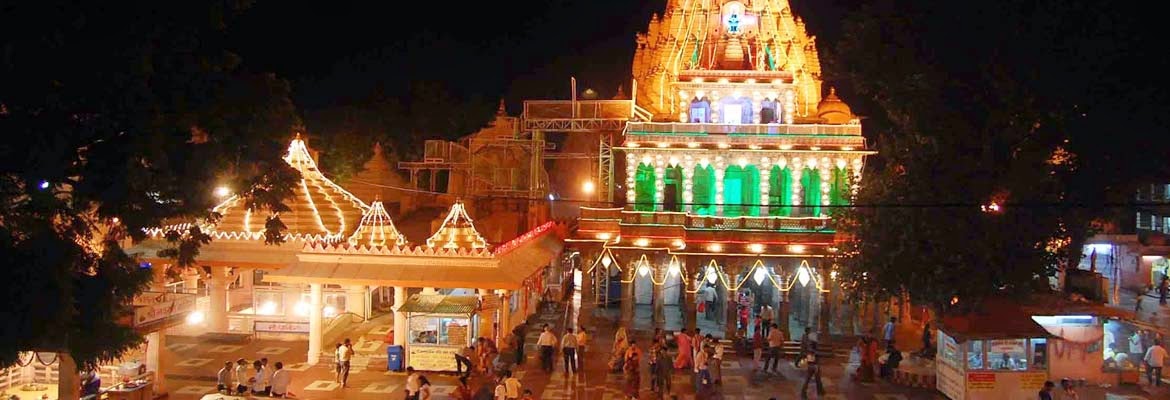Mahakaleshwar Jyotirlinga
The idol of Mahakaleshwar is known to be dakshinamurti, which means that it is facing the south. This is a unique feature, upheld by the tantric shivnetra tradition to be found only in Mahakaleshwar among the 12 Juotirlingas. The idol of Omkareshwar Mahadev is consecrated in the sanctum above the Mahakal shrine. The images of Ganesh Parvati and Karttikeya are installed in the west, north and east of the sanctum sanctorum. To the south is the image of Nandi, the vehicle of Lord Shiva. The idol of Nagchandreshwar on the third storey is open for Darshan only on the day of Nag Panchami.The temple has five levels, one of which is underground. The temple
itself is located in a spacious courtyard surrounded by massive walls
near a lake. The shikhar or the spire is adorned with sculptural finery. Brass lamps light the way to the underground sanctum. It is believed that prasada (holy offering) offered here to the deity can be re-offered unlike all other shrines.
The presiding deity of time, Shiva,in all his splendor, reigns eternally in the city of Ujjain. The temple of Mahakaleshwar, its shikhar soaring into the sky, an imposing façade against the skyline, evokes primordial awe and reverence with its majesty. The Mahakal dominates the life of the city and its people, even in the midst of the busy routine of modern preoccupations, and provides an unbreakable link with ancient Hindu traditions. On the day of Maha shivratri, a huge fair is held near the temple, and worship goes on through the night.In the precincts of the Mahakaleshwar temple is Shri Swapaneshwar Mahadev temple, where devotees pray to Shiva as Mahakaal, to realize the most important dreams of their lives. Sadashiv Mahadev is so empathetic, benevolent and easy to please that devotees are sure to be granted the boons they wish for with a pure heart in this temple, it is believed. Here Mahadev is Swapaneshwar and Shakti is Swapaneshwari.
According to the Purans,
the city of Ujjain was called Avantika and was famous for its beauty
and its status as a devotional epicenter. It was also one of the primary
cities where students went to study holy scriptures. According to
legend, there was a ruler of Ujjain called Chandrasena, who was a pious
devotee of Lord Shiva and worshiped him all the time. One day, a
farmer's boy named Shrikhar was walking on the grounds of the palace and
heard the King chant the Lord's name and rushed to the temple to start
praying
with him. However, the guards removed him by force and sent him
to the outskirts of the city near the river kshipra.
Rivals of Ujjain, primarily King Ripudamana and King Singhaditya of the
neighboring kingdoms decided to attack the Kingdom and take over its
treasures around this time. Hearing this, Shrikhar started to pray and
the news spread to a priest named Vridhi. He was shocked to hear this
and upon the urgent pleas of his sons, started to pray to Lord Shiva at
the river kshipra The Kings chose to attack and were successful; with the help of the powerful demon Dushan, who was blessed by Lord Brahma to be invisible, they plundered the city and attacked all the devotees of Lord Shiva.
Upon hearing the pleas of His helpless devotees, Lord Shiva appeared in his Mahakala form and destroyed the enemies of King
Chandrasena. Upon the request of his devotees Shrikhar and Vridhi, Lord
Shiva agreed to reside in the city and become the chief deity of the
Kingdom and take care of it against its enemies and to protect all His
devotees. From that day on, Lord Shiva resided in His light form as
Mahakala in a Lingam that was formed on its own from the powers of the Lord and His consort, Parvati.
The Lord also blessed his devotees and declared that people who
worshipped Him in this form would be free from the fear of death and
diseases. Also, they would be granted worldly treasures and be under the
protection of the Lord himself







No comments:
Post a Comment